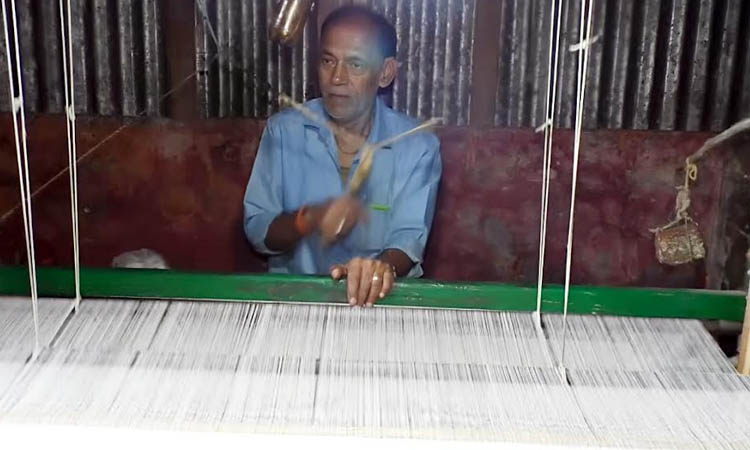News Flash

By Delowar Hossain Akaid
CUMILLA, Sept 13, 2025 (BSS) - Khadi, the hand-spun fabric deeply rooted in Bangladesh's history, culture, and economy, stands as a symbol of identity, self-reliance, and resilience.
Cumilla is regarded as the birthplace of Khadi. Centuries ago, the hand-woven Khadi fabric produced by its weavers earned fame across the Indian subcontinent. Even today, whenever Khadi is appeared, the name of Cumilla is pronounced with special reverence.
Despite its rich legacy, Cumilla's traditional Khadi industry now faces existential challenges. Traders cite the influx of cheap foreign fabrics, dominance of machine-made textiles, shortage of skilled artisans, and limited government support in financing and marketing as major obstacles. Hand-woven Khadi is on the verge of fading out.
Following its recent recognition as a Geographical Indication (GI) product, demand for Cumilla's Khadi has surged. However, stakeholders stress that government intervention is crucial to ensure quality production and meet market expectations.
Historical records traced the origins of Cumilla's Khadi to the Mughal era, but its prominence grew during the anti-colonial movement. In 1921, Mahatma Gandhi's visit to Cumilla during the Non-Cooperation Movement inspired widespread adoption of Khadi, transforming it into a symbol of rural self-sufficiency.
In 1975, the Bangladesh Small and Cottage Industries Corporation (BSCIC) initiated efforts to revive the Khadi sector, establishing several Khadi villages in Cumilla. Yet, over time, the industry declined due to a lack of modern technology, competition from imported fabrics, and weak marketing strategies.
Today, Khadi production survives in limited pockets, particularly in the villages of Chandina and Muradnagar upazilas. While nearly 300 shops along Kandirpar, Rajganj, and Laksam Road sell Khadi, most of it is machine-made. Authentic hand-woven Khadi is nearing extinction.
In Debidwar's Boro Kamta village, two of the last generation traditional weavers -- Chintaharan Debnath and Ranjit Debnath -- continue their craft.
"Machine-made Khadi and hand-woven Khadi may look the same, but in terms of quality, the difference is like heaven and earth," said Chintaharan, adding, "Those who know genuine Khadi still search for it and buy it."
Ranjit continued, "Once there were many looms, now only a few remain. With government support, hand-woven Khadi can be revived."
Local entrepreneur Shahana Begum echoed the concern, saying, "We're trying to preserve the heritage, but survival is difficult without substantial government assistance."
Besides, urban trader Tapan Pal remarked, "We are struggling to keep alive this symbol of a century-old heritage. But alone, it is not possible for us."
Mentioning that at home and abroad, demand for eco-friendly fabrics is rising, he said "Handspun natural Khadi can easily capture that market. If the government expands export facilities and promotional efforts, Cumilla's Khadi could become a global brand."
Historian Ahsanul Kabir noted, "Khadi is not just fabric, it's a testament to patriotism. The government could initiate a revival project similar to that of Muslin."
The decline of the Khadi industry stems from multiple factors: difficulty in sourcing quality cotton and yarn, competition from modern looms, dominance of cheap imports, lack of bank loans and incentives for small entrepreneurs, disinterest among youth, and poor international marketing.
Yet, the GI recognition has sparked renewed interest among locals and traders. Pradip Kanti Raha, President of the Cumilla Khadi Cloth Traders' Association, said, "We anticipated modest demand, but it has grown significantly. Government support is essential to expand the market."
He added, "Since Comilla's Khadi, the symbol of century-old tradition, has received geographical recognition, the government's responsibility has increased. It must ensure entry into foreign markets, modernization of design and involvement of the young generation."
Cumilla Deputy Commissioner Amirul Kaisar remarked that a proposal will be submitted to the Ministry of Textiles and Jute for the restoration of the Khadi industry. "With GI recognition, Cumilla's Khadi can be developed as a global brand," he said.
Local cultural eminent persons believe that Khadi is more than fabric - it is a living legacy of the Bangalee nation's struggle, dignity, and craftsmanship. Though weakened by modern challenges, the potential remains intact.
With proper planning, policy support, and modern marketing strategies, Cumilla's Khadi can once again shine - not just in the country's markets, but across the globe.